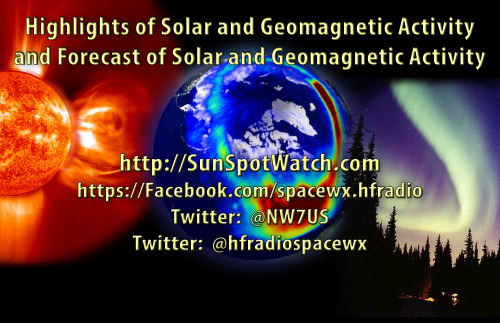The NW7US Beacon
RSS
Here is this week’s space weather and geophysical report, issued 2015 May 25 0854 UTC.
Highlights of Solar and Geomagnetic Activity 18 - 24 May 2015
Solar activity was at low levels from 18-23 May with very low levels observed on 24 May. Only low level isolated C-class flaring was observed during the period originating from Regions 2349 (S21, L=002, class/area Dao/060 on 24 May), 2351 (N22, L=330, class/area Cso/020 on 20 May), and 2353 (N07, L=344, class/area Dao/060 on 24 May). Region 2339 (N13, L=129, class/area Fkc/900 on 08 May), which was very productive last period, decayed as it quietly rotated around the NW limb on 18 May. Region 2349 emerged on the visible disk on 18 May, but did not show any significant growth until 23 May. Region 2353 emerged on 21 May and exhibited growth through the end of the period. However, both regions only managed 60 millionths of coverage by the end of the period. No Earth directed coronal mass ejections were observed.
No proton events were observed at geosynchronous orbit.
The greater than 2 MeV electron flux at geosynchronous orbit was at normal levels on 19 and 24 May, moderate levels from 20-23 May, and at high levels on 18 May.
Geomagnetic field activity ranged from quiet to major storm conditions. The period began under the influence of a co-rotating interaction region followed by a positive polarity equatorial coronal hole high speed stream (CH HSS). Total field increased to a maximum of 18 nT at 19/0052 UTC while the Bz component fluctuated between +13 nT and -15 nT late on 18 May through early on 19 May. Solar wind increased to near 575 km/s by midday on 19 May before slowly returning to nominal conditions by late on 20 May. The geomagnetic field responded with minor to major storm conditions late on 18 May through early on 19 May. Quiet to unsettled levels were observed on 20 May. A return to quiet conditions occurred on 21 May and persisted through the end of the period.
Forecast of Solar and Geomagnetic Activity 25 May - 20 June 2015
Solar activity is expected to be at very low to low levels. A chance for moderate levels exists from 30 May through 11 Jun with the return of Region 2339.
No proton events are expected at geosynchronous orbit.
The greater than 2 MeV electron flux at geosynchronous orbit is expected to be at normal to moderate levels with high levels possible from 31 May-01 Jun, 04-06 Jun, 10-12 Jun, and 16-20 Jun due to recurrent CH HSS effects.
Geomagnetic field activity is expected to be at unsettled to active levels from 28-30 May, 02-03 Jun, 07-11 Jun, and 13-15 Jun with possible minor storm levels on 08-09 Jun due to recurrent CH HSS effects.
Don’t forget to visit our live space weather and radio propagation web site, at: http://SunSpotWatch.com/
Live Aurora mapping is at http://aurora.sunspotwatch.com/
If you are on Twitter, please follow these two users: + https://Twitter.com/NW7US + https://Twitter.com/hfradiospacewx
Get the space weather and radio propagation self-study course, today. Visit http://nw7us.us/swc for the latest sale and for more information!
Check out the stunning view of our Sun in action, as seen during the last five years with the Solar Dynamics Observatory (SDO): https://www.youtube.com/watch?v=zXN-MdoGM9g
We’re on Facebook: http://NW7US.us/swhfr
